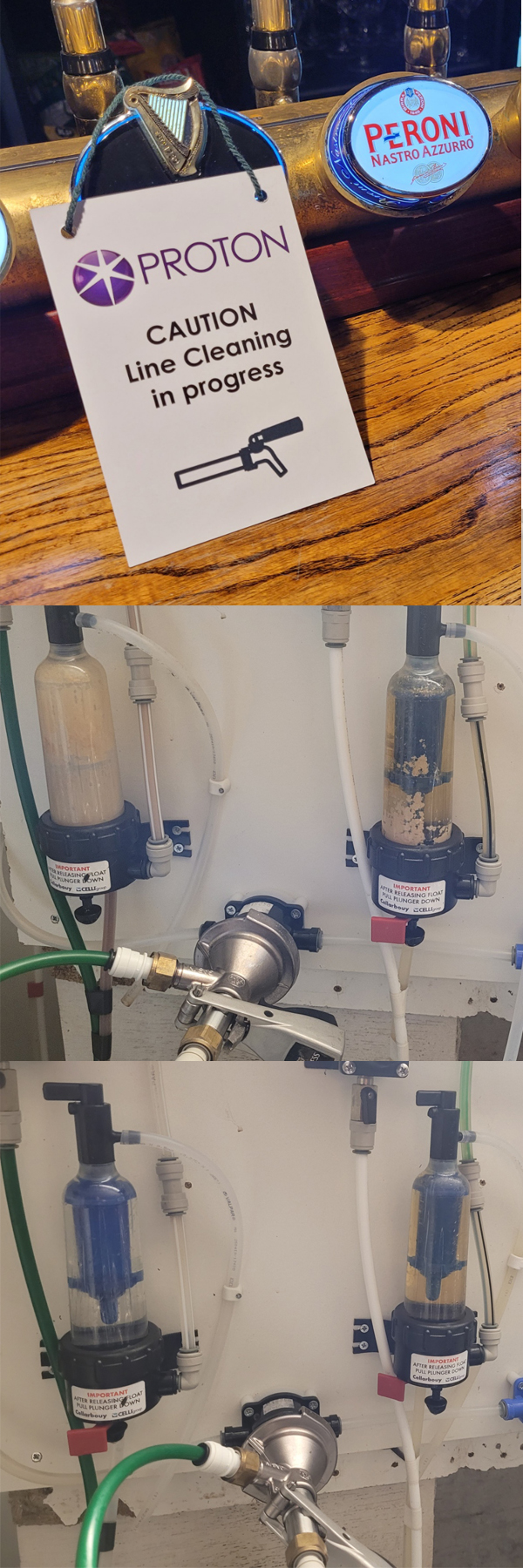Beer line cleaning
Keeping your beer lines in good condition is essential to ensure the quality of your beer. Everyone who serves draught beer should regularly clean their beer lines to stop the formation of yeast, limescale, bacteria and mould. Although cleaning your beer lines is a relatively simple task, it is time-consuming and, if not done correctly, will cause many issues.
We often see beer lines caked in yeast, even though the landlord assures us they clean the lines weekly, so here are a few tips to help keep your lines in tip-top condition. If you still need some help, please get in contact with us!
Chemical choice
Only use a good quality, branded chemical. Proton or Chemisphere are the main two. There are many non-branded ‘purple line cleaners’ available, and generally, they’re all pretty poor! Water hardness can also play a big part in successful cleaning. Check with the manufacturer to see if their chemical suits your area.
Mixture
It’s important to READ THE INSTRUCTIONS for the chemical you are using to get the dilution mix right. All cleaners are different, so a ‘couple of glugs’ in your cleaning bottle is not the best approach! A solution that is too weak will not clean the lines correctly. Too much chemical can taint the lines.
Time
Again, follow the manufacturer’s instructions. Line cleaning is time-consuming to do properly. There may be many cups of tea involved, some sitting around waiting, but do not rush things! Most manufacturers recommend a soak time of 10 minutes, then pulling through fresh cleaner. There are usually 3 or 4 cycles of doing this.
On the subject of time, it is worth considering WHEN you do your line cleaning. This should be done when the pub is closed for service, and ideally when there are no other staff behind the bar. It is very worthwhile investing in some ‘line cleaning in progress’ signage which can be bought for a couple of quid.
Rinsing
We recommend flushing the system with water BEFORE you start line cleaning to remove all the beer from the lines. The are some people that fill the lines with the solution without flushing the beer through first. We find this can cause the cleaning solution to be diluted with the beer, so we always like to start with a clean water flush. Once you have finished the line cleaning, it is important to flush the lines with plenty of clean water. Make sure you rinse out your cleaning bottle first! If you are unsure of how much water to pull through (4-5 pints should be enough), colour-changing test strips are available to check if any chemicals are remaining.
Couplers, taps, fobs & nozzles
These are just as important as the beer lines themselves. Make sure you clean both the keg couplers and the cleaning sockets before you start. Sanitising spray is available from main brewers and Proton. Sanitising tablets are also available for your nozzles. When it comes to the fobs, make sure you bleed through plenty of solution, and also rinse well.
Cellar environment
Although not strictly related to line cleaning, the cleanliness and temperature of your cellar can make a huge difference to the dispensing system. Ideally, your cellar wants to be at a constant 12-14 degrees celsius if you serve cask beers. For kegged beers only, this is not quite so important, but warm temperatures in the cellar can cause yeast and other contaminants to form much more quickly.
Hops & Bubbles offer one-off blitz cleans, regular line cleans and staff training to ensure your lines are always in good condition. Working within 30 miles of our base in RH8, please feel free to contact us to discuss your requirements.

